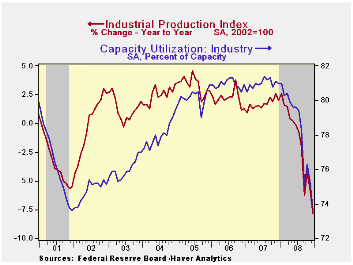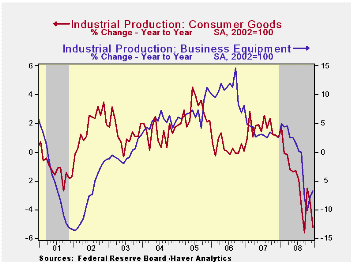 Global| Jan 16 2009
Global| Jan 16 2009U.S. Factory Output Fell Again in December; 2008 Decline The Largest Since 1975
by:Tom Moeller
|in:Economy in Brief
Summary
Industrial production during December fell for the ninth month of 2008. The 2.0% drop followed a 1.3% November decline which was revised deeper from the initial report. Last month's decline was double Consensus expectations for a 1.0% [...]

Industrial production during December fell for the ninth month of 2008. The 2.0% drop followed a 1.3% November decline which was revised deeper from the initial report. Last month's decline was double Consensus expectations for a 1.0% decline. For the year, industrial production declined 7.8% which was the sharpest negative twelve-month change since the deep recession of 1975.
Factory output took the brunt of the recession's force and declined 9.9% last year. That was led by a 13.9% twelve-month decline in output of construction supplies, again the deepest since 1975. Output of consumer goods fell 5.2% during last year, pulled lower by a 26.7% December-to-December drop in the output of motor vehicles & parts. That came on top of roughly 3% declines during the prior two years. Outside of the auto sector output also was hard it and production of furniture fell 21.9% while apparel output dropped 6.0%. Production of business equipment was late to the recession's downturn, but for the year production fell 6.7%.
Industrial production in the high-tech sector fell 6.5% last year. That was the worst performance since 2001. Outside of high-tech production declines amounted to 11.0% for the year, the worst decline since 1975.
Less the weakness in autos and high tech, output fell 6.9% last year, the steepest since 1982. Machinery production led that fall with a steep 11.6% drop while output of electrical equipment production also fell, but by 9.5% y/y. Production of chemicals fell 11.6% y/y, also the worst since 1975, but apparel output fell a modest 6.0%.
Capacity utilization fell to 73.6%, the lowest level since 2003. Utilization in the factory sector dropped further, however, to 70.2%, its lowest since 1982. Capacity in the factory sector increased a firm 1.7% y/y).
| INDUSTRIAL PRODUCTION (SA, %) | December | November | Y/Y | 2008 | 2007 | 2006 |
|---|---|---|---|---|---|---|
| Total Output | -2.0 | -1.3 | -7.8 | -1.8 | 1.7 | 2.2 |
| Manufacturing | -2.4 | -2.2 | -9.9 | -2.5 | 1.7 | 2.4 |
| Consumer Goods | -1.7 | -1.0 | -5.2 | -2.1 | 1.7 | 0.3 |
| Business Equipment | 1.8 | 2.9 | -6.7 | -1.1 | 3.3 | 10.4 |
| Construction Supplies | -3.3 | -4.6 | -13.9 | -6.1 | -2.5 | 2.2 |
| Utilities | -0.1 | 0.9 | 0.5 | 0.4 | 3.3 | -0.6 |
| Capacity Utilization | 73.6 | 75.2 | 81.0 (Dec.'07) | 78.2 | 81.0 | 80.9 |
Tom Moeller
AuthorMore in Author Profile »Prior to joining Haver Analytics in 2000, Mr. Moeller worked as the Economist at Chancellor Capital Management from 1985 to 1999. There, he developed comprehensive economic forecasts and interpreted economic data for equity and fixed income portfolio managers. Also at Chancellor, Mr. Moeller worked as an equity analyst and was responsible for researching and rating companies in the economically sensitive automobile and housing industries for investment in Chancellor’s equity portfolio. Prior to joining Chancellor, Mr. Moeller was an Economist at Citibank from 1979 to 1984. He also analyzed pricing behavior in the metals industry for the Council on Wage and Price Stability in Washington, D.C. In 1999, Mr. Moeller received the award for most accurate forecast from the Forecasters' Club of New York. From 1990 to 1992 he was President of the New York Association for Business Economists. Mr. Moeller earned an M.B.A. in Finance from Fordham University, where he graduated in 1987. He holds a Bachelor of Arts in Economics from George Washington University.






